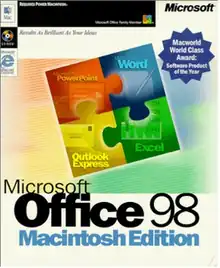Microsoft Office 98 Macintosh Edition
Microsoft Office 98 Macintosh Edition is a version of Microsoft Office for the classic Mac OS, unveiled at Macworld Expo/San Francisco on January 6, 1998. It introduced the Internet Explorer 4.0 browser and Outlook Express, an Internet e-mail client and usenet newsgroup reader. Office 98 was re-engineered by Microsoft's Macintosh Business Unit to satisfy customers' desire for more Mac-like software.
 The box for Microsoft Office 98 Macintosh Edition | |
| Developer(s) | Microsoft |
|---|---|
| Initial release | April 1998 |
| Final release | Service Release 5
/ November 29, 2002 |
| Operating system | Classic Mac OS |
| Type | Office suite |
| License | Commercial Proprietary software |
There are two editions of Office 98: Gold and Standard.
It included drag-and-drop installation, self-repairing applications and Quick Thesaurus, before such features were available in a version of Office for Windows. It also was the first version to support QuickTime movies. The applications in Microsoft Office 98 were:
- Microsoft PowerPoint 98
- Microsoft Word 98.
- Microsoft Excel 98
- Outlook Express 4.0
- Internet Explorer 4.0
Another rare edition of Microsoft Office 98 Macintosh Edition was published titled: "Microsoft Office 98 Macintosh Gold Edition." This version included everything the normal version included plus Microsoft FrontPage Version 1.0 for Macintosh, Microsoft Bookshelf 98 reference software, and Microsoft Encarta 98 Macintosh Deluxe Edition.
Service releases
| Release date | Version |
|---|---|
| December 12, 1998 | SR-1 |
| March 11, 1999 | SR-1.5 |
| June 14, 1999 | SR-1.9 |
| February 17, 2000 | SR-2 |
| September 14, 2000 | SR-2.5 |
| June 15, 2001 | SR-3 |
| May 17, 2002 | SR-4 |
| November 29, 2002 | SR-5 |
System requirements
- A Mac OS-compatible computer equipped with a PowerPC processor.
- System 7.5 operating system or later.
- At least 16 MB of physical RAM to run one application, 32 MB recommended to run multiple applications.
- Sufficient hard disk space, depending on installation method: 'Drag and drop' or 'Easy' (90 MB), 'Complete' (min. 43 MB to max. 110 MB) or 'Run from CD or Run from network' (7 MB on the client hard disk).
- One CD-ROM drive.
- An 8-bit color or 4-bit gray-scale display with at least 640 × 400 resolution.
Source of above.[1]
References
Further reading
- "Review: Microsoft Office 98 Macintosh Edition. (Software Review) (Evaluation) (Brief Article)". MacWEEK. March 23, 1998. Retrieved 2008-11-17.
- "Solid Office 98 does the Mac proud. (business application suite from Microsoft) (Software Review)(Evaluation)". MacWEEK. January 5, 1998. Retrieved 2008-11-17. Beta test review.
- "Microsoft again allies with Mac for Office 98". The Atlanta Journal and The Atlanta Constitution. January 4, 1998. p. H02. Retrieved 2008-11-17.
- Cavanah, Cassandra (June 1, 1998). "Mac's back! (Microsoft Office 98 for Macintosh) (Software Review) (Evaluation)". Entrepreneur. Archived from the original on October 22, 2012. Retrieved 2008-11-17.
- Crabb, Don (January 1, 1998). "Microsoft Office even better for '98". Chicago Sun-Times. Retrieved 2008-11-17.
External links
- Official website
- Microsoft PowerPoint 98 Viewer at the Wayback Machine (archived October 23, 2007)